Not known Details About Red Wiggler Express
Not known Details About Red Wiggler Express
Blog Article
An Unbiased View of Red Wiggler Express
Table of ContentsThe Main Principles Of Red Wiggler Express The Only Guide to Red Wiggler ExpressThe Greatest Guide To Red Wiggler ExpressSee This Report on Red Wiggler ExpressSee This Report about Red Wiggler Express
It's secure to state this stuff would have been terrific to include as a to vermicomposting systems! And the thriving Red Worm population? It just never occurred. Also in the heap that was established straight in front of yard composters with existing Red Worm colonies. These nutritionally-boosted timber chip environments are absolutely filled with Lumbricus sp.
Lots of selections, including Red Wigglers, European Nightcrawlers, and Lumbricus types were brought over from the European continent. However below's the thingNative or otherwise - and as skilled as they are at having the ability to survive in a wide-range of atmospheres and conditions -. Simply put, they are even more most likely to hang out in any kind of energetic composting systems you have actually established up, than they are to wander off and start ruining the environment.
Roots need oxygen for respiration and depend on smooth airflow within the soil to prosper. When it rainfalls, soil can come to be saturated with water, lowering the oxygen readily available and hindering vitamins and mineral absorption. To keep an optimal equilibrium, the soil should permit water to drain appropriately, leaving sufficient room for air to support origin health and wellness
Facts About Red Wiggler Express Uncovered

When it comes to worms for composting, what comes to mind? If you were an earthworm breeder, supplier, or ordinary garden enthusiast, after that you 'd recognize that red wiggler worms are the ideal worms for vermicomposting. To find out more about these earth marvels, checked out some of the red worm facts below.
(https://freeweblink.org/details.php?id=273641)Yet if they stretch their bodies, you'll be able to see the red stripes on their skin. When increasing worms such as red wiggler worms, you need to be able to understand how to profit them. When you're able to maintain and look after their environment well, and likewise feed them the best type of organic wastes, then they'll be able to generate nutrient-packed and quality-rich worm spreadings for you (additionally called worm poop or garden compost).
Little Known Questions About Red Wiggler Express.
So, what do worms consume? Well, these red wriggler worms can be fed with cooking area scraps and garden wastes. So, any kind of rotting natural stuff will simulate veggie and fruit peels, smashed egg coverings, utilized tea bags, coffee grounds, grass clippings, dry leaves, and others. Yet see to it not to feed them foodstuffs that are oily, citrusy, or has meat or dairy in them. Where To Buy Worms.

This behavior makes them appropriate permanently in worm containers, compost heap, and various other constrained spaces where natural waste is abundant. Creating an optimum atmosphere for red wigglers calls for a thoughtful strategy. Think about the complying with important aspects to look after red wigglers at home and ensure their well-being: Utilize a bed linen of shredded newspaper or cardboard.

Add a handful of dry, shredded newspaper if the container ends up being also wet. Undoubtedly, they do! Red wiggler worms duplicate by laying tiny, lemon-shaped eggs in safety cocoons. These cocoons are normally transferred in the bed linens and hatch right into infant worms within a couple of weeks. The rapid recreation cycle of red wigglers is just one of the factors they are preferred for vermicomposting.
The Ultimate Guide To Red Wiggler Express
Their versatility and strength have made them a prominent selection for vermicomposting in numerous areas around the world. Yes! They can survive from a series of 32F to 90F. They are incredibly adaptable critters. Take into consideration safety procedures for extremely severe temperature levels such as: Protecting the worm container with layers of straw or leaves.

Just remember - you can always add even more food later (however it's tough to remove feed once it's been included to a container!).
Because I fed the red wigglers and garden compost worms as well much, they weren't able to maintain and gradually the older food went uneaten and developed anaerobic problems that eliminated the worms. The great news is that there are very simple actions you can require to ensure this doesn't occur! Below're the 6 gold policies for exactly how typically and just how much to feed your worms: Guideline # 1: Moderation! You can always include more food later.
How Red Wiggler Express can Save You Time, Stress, and Money.
Uneaten food will certainly lead to anaerobic conditions that will certainly eliminate your online worms. It is ok to spray a little of their original bed linens (which must already remain in the bin) over the food, yet the food should never be hidden and need to show up to your eye. Policy # 5: See rule # 1! Policy # 6: After the first feeding, feed the worms 1/3 to 1/2 of their weight.
Report this page